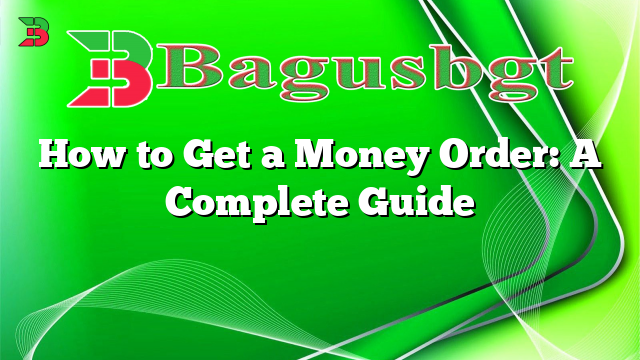Hello and welcome to our comprehensive guide on how to get a money order. In this article, we will walk you through the entire process of obtaining a money order, step by step, to ensure a smooth and hassle-free experience. Whether you need a money order for personal or business purposes, we’ve got you covered. Let’s dive in!
Subheading 1: Understanding Money Orders
Before we delve into the specifics of how to get a money order, let’s first understand what exactly a money order is. A money order is a convenient and secure form of payment that functions similarly to a check. It is a prepaid instrument issued by a financial institution, such as a bank or a post office, that guarantees the recipient will receive the specified amount of money.
Money orders are often preferred in situations where personal checks are not accepted or when a more secure form of payment is required. They are widely used for various purposes, including rent payments, utility bills, sending money to family or friends, and making purchases from individuals or businesses that do not accept cash.
Subheading 2: Finding a Provider
The first step in obtaining a money order is finding a reliable provider. Fortunately, there are several options available. The most common providers include banks, credit unions, post offices, and retail stores. It’s essential to choose a provider that is convenient for you and offers competitive fees.
When selecting a provider, consider factors such as location, operating hours, fees, and any additional services they may offer. It’s a good idea to compare the fees charged by different providers to ensure you get the best deal.
Subheading 3: Required Documentation
Once you have chosen a provider, you will need to gather the necessary documentation to complete your money order transaction. The exact requirements may vary depending on the provider, but generally, you will need:
- Valid identification: This can be a driver’s license, passport, or any other government-issued ID.
- Recipient’s information: You will need the full name and address of the person or business to whom you are sending the money order.
- Payment: Be prepared to pay for the money order upfront, usually in cash or by using a debit card.
Subheading 4: Filling Out the Money Order
Once you have gathered the required documentation, it’s time to fill out the money order. The process is straightforward, but it’s important to be accurate to avoid any complications. Here’s what you need to do:
- Write the recipient’s name: Clearly write the full name of the person or business who will receive the money order.
- Fill in your information: Provide your full name and contact information in the designated fields.
- Include a memo (optional): If you wish to include a note or reference, you can write it in the memo section.
- Sign the money order: Sign your name on the designated line to authorize the money order.
Subheading 5: Paying for the Money Order
After filling out the money order, you will need to pay for it. As mentioned earlier, most providers accept cash or debit card payments. Some providers may also accept other forms of payment, such as traveler’s checks or money from your bank account.
Ensure you have the necessary funds to cover the amount of the money order plus any applicable fees. Keep in mind that you may need to pay an additional fee if you are using a credit card to purchase the money order.
Subheading 6: Retaining Your Receipt
Once the transaction is complete, it’s crucial to retain your receipt. The receipt serves as proof of payment and contains important details, such as the money order number and the exact amount sent. Keep it in a safe place until the money order has been successfully delivered or cashed.
Subheading 7: Advantages of Money Orders
Money orders offer several advantages over other forms of payment:
- Security: Money orders are a secure payment method as they require upfront payment and are traceable.
- Widely accepted: Money orders are generally accepted by individuals, businesses, and organizations.
- No bank account required: You can easily obtain a money order without having a bank account.
- Trackable: Most money orders come with tracking options, allowing you to monitor the delivery progress.
Subheading 8: Disadvantages of Money Orders
While money orders offer several benefits, they also have a few drawbacks to consider:
- Cost: Money orders come with fees, which can vary depending on the provider and the amount of money being sent.
- Maximum limits: Some providers impose maximum limits on the amount you can send via a money order.
- Non-refundable: Once a money order is issued, it is generally non-refundable, so be cautious when sending large sums or to unfamiliar recipients.
Subheading 9: Alternative Options
If obtaining a money order doesn’t suit your needs, there are alternative options available:
- Online payment platforms: Services like PayPal, Venmo, and Zelle offer convenient ways to send money electronically.
- Bank transfers: If you have a bank account, you can transfer funds directly to the recipient’s account.
- Cashier’s checks: Similar to money orders, cashier’s checks are issued by banks and can be used for larger transactions.
Subheading 10: Money Order Guide Table
Provider |
Location |
Operating Hours |
Fees |
Maximum Limit |
|---|---|---|---|---|
Bank A |
Main Street |
9am-5pm |
$1.50 |
$1,000 |
Post Office |
City Center |
8am-6pm |
$1.20 |
$500 |
Retail Store |
Mall Avenue |
10am-9pm |
$2.00 |
$750 |
Conclusion
Obtaining a money order is a simple and secure way to make payments when cash or personal checks are not viable options. By following the steps outlined in this guide, you can confidently obtain a money order and complete your transactions with ease. However, it’s always wise to consider alternative payment methods and weigh the advantages and disadvantages before making a final decision. Remember to choose a provider that suits your needs and offers competitive fees. Happy money ordering!
Frequently Asked Questions (FAQ)
Q: Can I get a money order without a bank account?
A: Yes, you can easily obtain a money order without having a bank account. Money orders are available through various providers, including banks, credit unions, post offices, and retail stores.
Q: Are money orders traceable?
A: Most money orders come with tracking options, allowing you to monitor the delivery progress. This feature provides added security and peace of mind.
Q: Can I get a refund for a money order?
A: Generally, money orders are non-refundable once issued. It’s essential to double-check all the details before purchasing a money order to avoid any mistakes or complications.
Q: Is there a limit on the amount I can send via a money order?
A: Some providers impose maximum limits on the amount you can send via a money order. Make sure to verify the limits with your chosen provider before initiating the transaction.
 Bagus Banget Kumpulan Informasi terbaru dari berbagai sumber yang terpercaya
Bagus Banget Kumpulan Informasi terbaru dari berbagai sumber yang terpercaya





